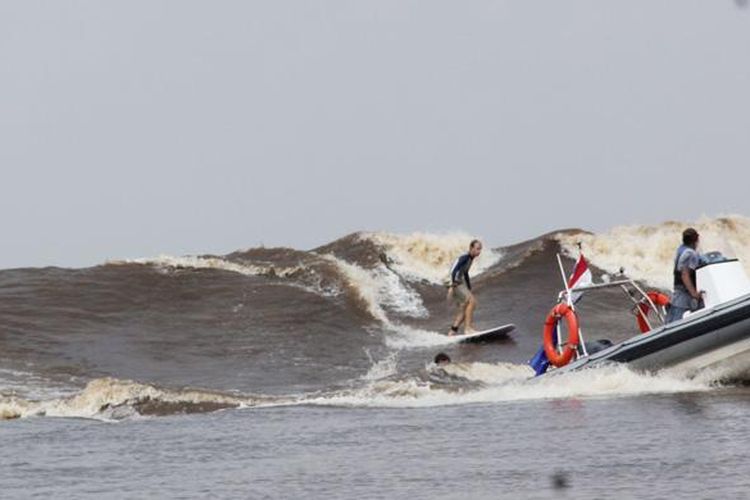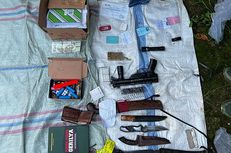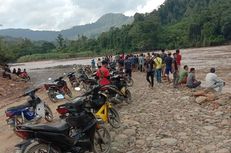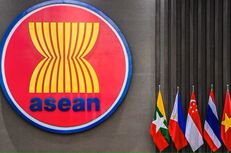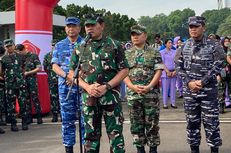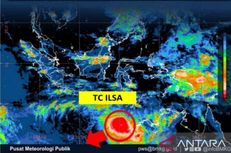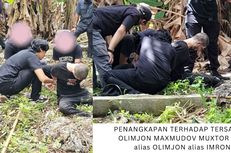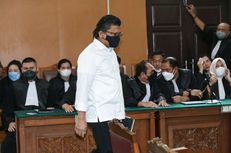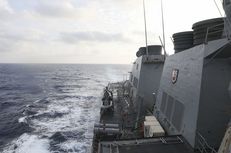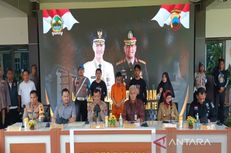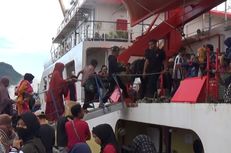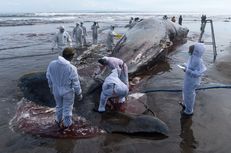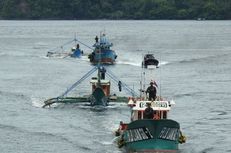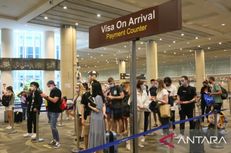Surfing Down Indonesia's Kampar River
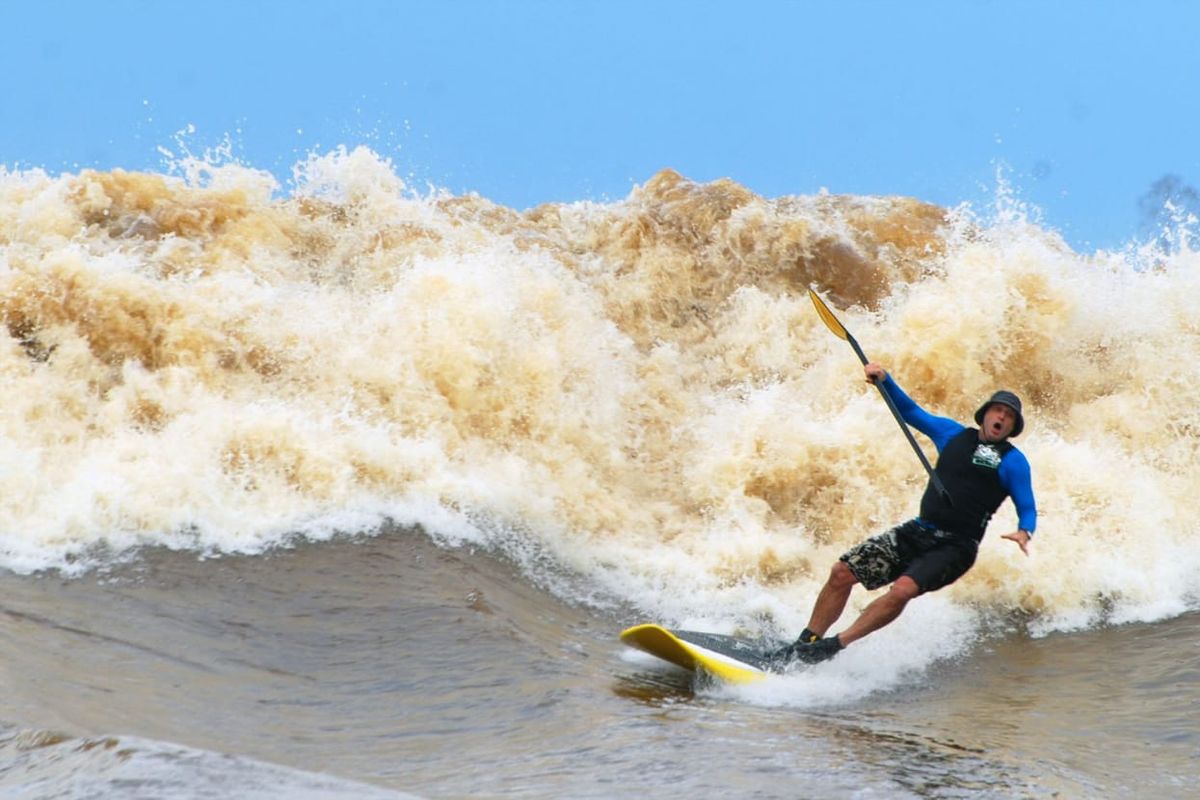
KOMPAS.com - The roar of the waves filled the ears of the surfers, as well as those watching on land watching them wade out to the waves. One can assume that this scene took place in Bali, Australia and Hawaii, but in fact it is none of the above.
Instead, this quest for the perfect wave took place on the shores of the Kampar River in the Pelalawan Regency of Indonesia's Riau province.
Known as bono waves, from the Melayu language term for ‘brave’, the breakers roll the length of the estuary from the villages of Pulau Muda to Teluk Meranti and Tanjung Mentangor.
Also read: Indonesia Weather Agency Warns of Tide Floding in Coastal Areas due to Lunar Eclipse
In the estuary, bono waves can reach speeds of 50 to 60 km, though it moves at an average speed of 40 km an hour, and heights of four to five meters. The waves will shrink no more than 70 centimeters to one meter the farther it gets from the estuary.
These big waves are distinct from their ocean going counterparts because they flow against the river current. And unlike the swells of the open sea, bono waves can reach lengths of 200 meters to two kilometers, depending on the river shores.
Confluence of three currents
While bono waves is distinct from ocean tides, they still owe their formation to the open sea.
"Bono waves are created when waves from the Malacca Strait and the South China Sea converge with the mouth of the Kampar River," said Ministry of Marine Affairs and Fisheries coastal environment researcher Guntur Adhi Rahmawan.
Also read: Belitong Geopark Wins UNESCO Global Geopark Destination
"As the latter pass through the narrower and shallower Kampar watershed and meet the river flow, they will accelerate and bring about a big collision. The turbulence will produce large waves from four to five meters in height with a loud bang, similar to a tsunami wave."
But he pointed out that bono waves will continue to run along the watershed for about two hours, and gradually weaken with every turn of the river.
 Bono waves on the Kampar River, Riau
Bono waves on the Kampar River, RiauBono waves are known to be destructive, because they cause erosion in the Kampar River and overflow onto land. They often flood houses with inundations of up to one meter in depth, and capsize fishing boats.
Yet this phenomenon is not a daily occurrence. Bono waves come about at high tide during a full moon, particularly as water levels on the Kampar River rise during the peak of the rainy season between October to December. they also occur from February to March.
The myth of the seven ghosts
According to an age-old Malay folktale called Sentadu Laut, bono waves are the embodiment of seven ghosts which often destroy canoes or ships crossing the Kampar River.
The tale described the seven ghosts as seven types of waves, starting from the largest wave in front, and followed by six waves that get successively smaller.
As objects of fear, the community elders would lead the inhabitants in holding a ceremony to placate the waves for their safety. On the other hand, bono waves are also a way for Malay warriors on the coast to test their courage and improve their fighting skills.
 Local youth from Teluk Meranti Village, Teluk Meranti District, Pelalawan Regency, Riau, having fun enjoying the bono waves. They are no longer afraid to face the bono that was once called the seven ghosts.
Local youth from Teluk Meranti Village, Teluk Meranti District, Pelalawan Regency, Riau, having fun enjoying the bono waves. They are no longer afraid to face the bono that was once called the seven ghosts.Surfing records
Bono waves remained Riau's best kept secret until Antony Colas, author of the surfing guidebook, World Stormrider Guide, visited the area in September 2010.
Colas was dumbfounded by the huge rolls of bono waves in the river that are similar to those in the sea. He recounted that bono waves are distinct from ocean waves in that the former can reach speeds of up to 50 km.
Colas's writing aroused the curiosity of American three-time world surfing champion Tom Curren. This 60-year-old senior surfer invited fellow world champions Bruno Santos and Dean Brady to try and conquer the bono waves.
Also read: Indonesia's Toba Caldera Recognized as UNESCO Global Geopark
He also successfully surfed for almost an hour in March 2011. "After more than 30 years of surfing, this is the first time I felt a very long surf on the waves and it happened in the river," Curren said as quoted from the Surfer Today website.
The world record for longest surfing recorded in the Guinness Book of World Records was also broken twice at the Kampar River.
The first record was set by British surfer Steve King on February 15, 2013. At that time, he and fellow surfers Steve Holmes and Nathan Maurice rode a four meter high bono over a distance of 12.3 km for 1 hour 13 minutes in an agility competition.
 Australian surfer James Cotton (standing behind) set a world record for surfing bono waves of 17.2 kilometers, breaking British Steve King's record of 12.23 kilometers set in 2013.
Australian surfer James Cotton (standing behind) set a world record for surfing bono waves of 17.2 kilometers, breaking British Steve King's record of 12.23 kilometers set in 2013.King's record was then broken by Australian world champion James Cotton. The man from Down Under was able to ride bono waves of up to 3.5 meters over a lenght of 17.2 km for 1 hour 20 minutes.
Indonesian female surfer Gemala Hanafiah also hit the record books, when she and 30 national and international surfers tried to conquer The Wave of Seven Ghosts together.
"This feat would have been impossible to do in ocean waves, as they can only be surfed by up to three people for less than three minutes," she said. At the Kampar River, Gemala and her colleagues were able to surf for 30 minutes.
Pelalawan tourism
Like many wonders, taking on the Kampar River's bono waves require an odyssey. Specifically, one needs to travel overland for four hours from Pekanbaru, then go by speed boat to Teluk Meranti Village or Pulau Muda Village, the two best known venues to take on the bono wave.
The Pelalawan Regency administration has been obliging them since 2013, the year that they started to realize the bono waves' tourism potential, particularly among surfers.
Also read: West Sumatra's Traditional Bull Race 'Pacu Jawi' Steps Up On the Global Stage
They also hosted annual events to draw the latter, such as the International Bono Surfing Festival and Bekudo Bono. These events appeal to local people as well, many of whom climb hills the area to watch the surfers try their luck against the waves.
But regardless whether one is keen to get their feet wet or keep it dry, the bono waves are bound to draw anyone out for a trip to remember.
(Editor: Rachmawati)
Source:
Simak breaking news dan berita pilihan kami langsung di ponselmu. Pilih saluran andalanmu akses berita Kompas.com WhatsApp Channel : https://www.whatsapp.com/channel/0029VaFPbedBPzjZrk13HO3D. Pastikan kamu sudah install aplikasi WhatsApp ya.

